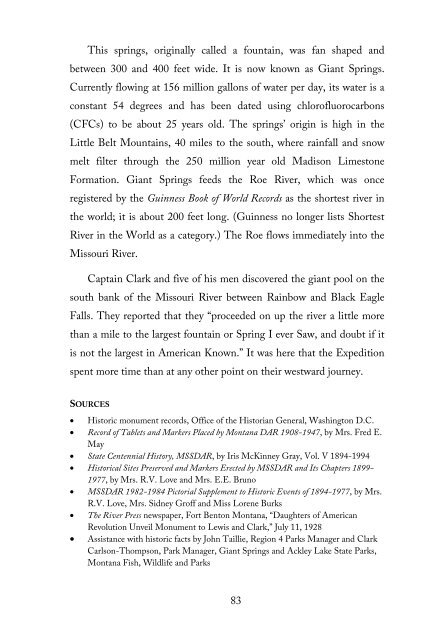Montana's DAR Markers . . . Honoring Where History Was Made
This book is a 200-page thank you to the women of Montana State Society Daughters of the American Revolution for their work in placing historical markers across the state of Montana. Starting in 1908, Montana DAR has installed 70 historical markers across the state. Of those, 33 remain. This book records why the markers’ sites were selected, their history, and the backstory of each.
This book is a 200-page thank you to the women of Montana State Society Daughters of the American Revolution for their work in placing historical markers across the state of Montana. Starting in 1908, Montana DAR has installed 70 historical markers across the state. Of those, 33 remain. This book records why the markers’ sites were selected, their history, and the backstory of each.
Create successful ePaper yourself
Turn your PDF publications into a flip-book with our unique Google optimized e-Paper software.
This springs, originally called a fountain, was fan shaped and<br />
between 300 and 400 feet wide. It is now known as Giant Springs.<br />
Currently flowing at 156 million gallons of water per day, its water is a<br />
constant 54 degrees and has been dated using chlorofluorocarbons<br />
(CFCs) to be about 25 years old. The springs’ origin is high in the<br />
Little Belt Mountains, 40 miles to the south, where rainfall and snow<br />
melt filter through the 250 million year old Madison Limestone<br />
Formation. Giant Springs feeds the Roe River, which was once<br />
registered by the Guinness Book of World Records as the shortest river in<br />
the world; it is about 200 feet long. (Guinness no longer lists Shortest<br />
River in the World as a category.) The Roe flows immediately into the<br />
Missouri River.<br />
Captain Clark and five of his men discovered the giant pool on the<br />
south bank of the Missouri River between Rainbow and Black Eagle<br />
Falls. They reported that they “proceeded on up the river a little more<br />
than a mile to the largest fountain or Spring I ever Saw, and doubt if it<br />
is not the largest in American Known.” It was here that the Expedition<br />
spent more time than at any other point on their westward journey.<br />
SOURCES<br />
• Historic monument records, Office of the Historian General, <strong>Was</strong>hington D.C.<br />
• Record of Tablets and <strong>Markers</strong> Placed by Montana <strong>DAR</strong> 1908-1947, by Mrs. Fred E.<br />
May<br />
• State Centennial <strong>History</strong>, MSS<strong>DAR</strong>, by Iris McKinney Gray, Vol. V 1894-1994<br />
• Historical Sites Preserved and <strong>Markers</strong> Erected by MSS<strong>DAR</strong> and Its Chapters 1899-<br />
1977, by Mrs. R.V. Love and Mrs. E.E. Bruno<br />
• MSS<strong>DAR</strong> 1982-1984 Pictorial Supplement to Historic Events of 1894-1977, by Mrs.<br />
R.V. Love, Mrs. Sidney Groff and Miss Lorene Burks<br />
• The River Press newspaper, Fort Benton Montana, “Daughters of American<br />
Revolution Unveil Monument to Lewis and Clark,” July 11, 1928<br />
• Assistance with historic facts by John Taillie, Region 4 Parks Manager and Clark<br />
Carlson-Thompson, Park Manager, Giant Springs and Ackley Lake State Parks,<br />
Montana Fish, Wildlife and Parks<br />
83





